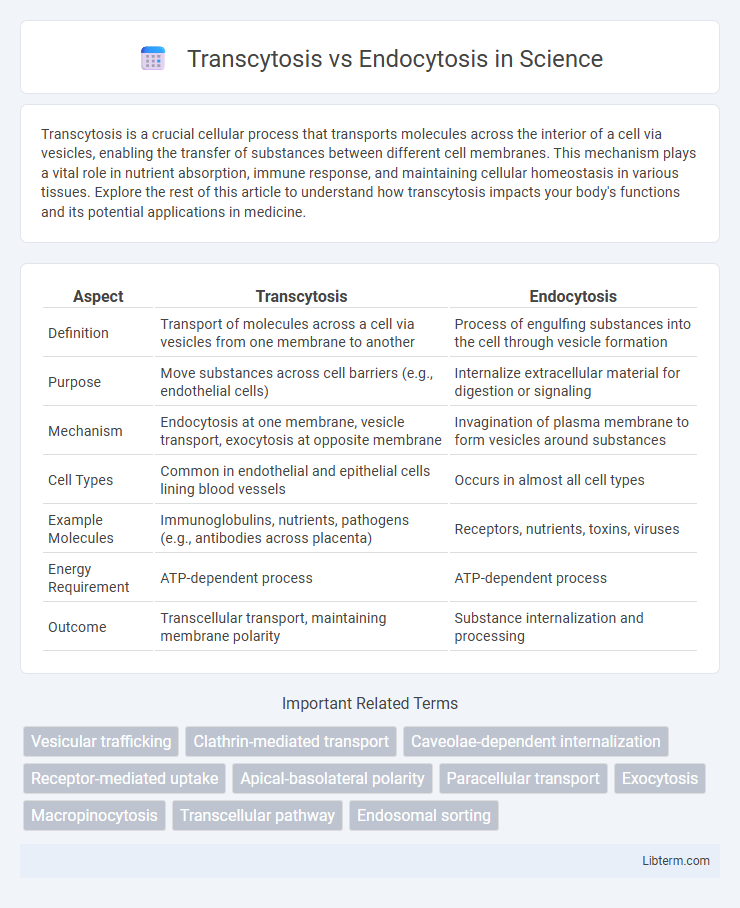Transcytosis is a crucial cellular process that transports molecules across the interior of a cell via vesicles, enabling the transfer of substances between different cell membranes. This mechanism plays a vital role in nutrient absorption, immune response, and maintaining cellular homeostasis in various tissues. Explore the rest of this article to understand how transcytosis impacts your body's functions and its potential applications in medicine.
Table of Comparison
| Aspect | Transcytosis | Endocytosis |
|---|---|---|
| Definition | Transport of molecules across a cell via vesicles from one membrane to another | Process of engulfing substances into the cell through vesicle formation |
| Purpose | Move substances across cell barriers (e.g., endothelial cells) | Internalize extracellular material for digestion or signaling |
| Mechanism | Endocytosis at one membrane, vesicle transport, exocytosis at opposite membrane | Invagination of plasma membrane to form vesicles around substances |
| Cell Types | Common in endothelial and epithelial cells lining blood vessels | Occurs in almost all cell types |
| Example Molecules | Immunoglobulins, nutrients, pathogens (e.g., antibodies across placenta) | Receptors, nutrients, toxins, viruses |
| Energy Requirement | ATP-dependent process | ATP-dependent process |
| Outcome | Transcellular transport, maintaining membrane polarity | Substance internalization and processing |
Introduction to Cellular Transport Mechanisms
Transcytosis enables molecules to be transported across the interior of a cell via vesicular trafficking, facilitating movement between distinct cellular compartments. Endocytosis involves the engulfment of extracellular substances by the plasma membrane to form vesicles, mediating nutrient uptake and receptor regulation. Both processes are essential cellular transport mechanisms contributing to selective material exchange and maintaining cellular homeostasis.
Overview of Endocytosis
Endocytosis is a cellular process where cells engulf external substances by invaginating the plasma membrane to form vesicles, enabling uptake of nutrients, signaling molecules, and pathogens. This mechanism includes several forms such as phagocytosis, pinocytosis, and receptor-mediated endocytosis, each specialized for different cargo and purposes. Endocytosis plays a critical role in cellular homeostasis, immune response, and membrane recycling.
Overview of Transcytosis
Transcytosis is a specialized cellular process that transports macromolecules across the interior of a cell by vesicular trafficking, enabling substances to move between the apical and basolateral surfaces, often in epithelial and endothelial cells. This mechanism plays a crucial role in nutrient absorption, immune surveillance, and maintaining the blood-brain barrier by selectively shuttling proteins, ions, and pathogens. Unlike endocytosis, which primarily involves the internalization of molecules for degradation or recycling, transcytosis ensures directional transport while preserving the integrity of the transported cargo.
Key Differences Between Transcytosis and Endocytosis
Transcytosis is a specialized cellular process that transports molecules across the interior of a cell, often involving the movement from one side of the cell to the other, whereas endocytosis primarily involves the engulfment and internalization of substances into the cell. Endocytosis includes mechanisms such as phagocytosis, pinocytosis, and receptor-mediated endocytosis, which capture extracellular materials for degradation or signaling. Key differences lie in the purpose and directionality: transcytosis facilitates directional transport and secretion across cellular barriers, while endocytosis mainly functions in nutrient uptake and membrane recycling.
Mechanisms of Endocytosis: Types and Functions
Endocytosis comprises several mechanisms including phagocytosis, pinocytosis, and receptor-mediated endocytosis, each facilitating cellular intake of substances with distinct specificity and function. Phagocytosis enables the engulfment of large particles or pathogens, crucial for immune defense, while pinocytosis nonspecifically absorbs extracellular fluids and solutes. Receptor-mediated endocytosis selectively internalizes molecules such as hormones and nutrients via ligand-receptor interaction, optimizing cellular uptake and signaling regulation.
Mechanisms of Transcytosis: Pathways and Processes
Transcytosis involves the transport of macromolecules across the interior of a cell via vesicular trafficking, primarily through two pathways: receptor-mediated and non-specific fluid-phase transcytosis. In receptor-mediated transcytosis, specific ligands bind to cell surface receptors, triggering endocytosis followed by vesicle transport across the cytoplasm and exocytosis at the opposite membrane. Key cellular components such as clathrin-coated pits, caveolae, and cytoskeletal elements facilitate vesicle formation, trafficking, and fusion, ensuring selective and directional molecular transport.
Physiological Roles of Endocytosis in Cells
Endocytosis is fundamental for nutrient uptake, receptor internalization, and membrane recycling, playing a critical role in cell survival and communication. It facilitates the regulated entry of extracellular molecules, enabling cellular responses to environmental signals and maintaining homeostasis. Transcytosis, by contrast, specifically mediates the transport of molecules across polarized cells, linking extracellular and intracellular compartments without degrading cargo.
Biological Importance of Transcytosis in Tissues
Transcytosis plays a critical role in maintaining tissue homeostasis by enabling the targeted transport of macromolecules and nutrients across polarized epithelial and endothelial cells without degradation. This selective vesicular trafficking supports processes such as nutrient absorption in the intestines, antibody transfer in the placenta, and barrier function modulation in the blood-brain barrier. Unlike endocytosis, which primarily internalizes substances for degradation or recycling within the cell, transcytosis allows efficient transcellular movement crucial for intercellular communication and immune defense.
Clinical Implications: Transcytosis vs Endocytosis in Drug Delivery
Transcytosis enables targeted drug delivery across cellular barriers such as the blood-brain barrier, enhancing therapeutic efficacy for neurological conditions. Endocytosis facilitates cellular uptake of drug carriers but may result in lysosomal degradation, limiting drug bioavailability. Optimizing transcytosis pathways improves drug transport efficiency, reduces systemic toxicity, and supports the development of advanced nanomedicine formulations.
Conclusion: Comparative Insights and Future Perspectives
Transcytosis enables the transport of molecules across polarized cells, maintaining cellular polarity, whereas endocytosis primarily involves internalizing substances into the cell for processing or degradation. Understanding the distinct molecular mechanisms and pathways of each process offers valuable insights into targeted drug delivery and diagnostic strategies. Future research focusing on manipulating these pathways could revolutionize therapeutic interventions for diseases involving barrier tissues like the blood-brain barrier and intestinal epithelium.
Transcytosis Infographic

 libterm.com
libterm.com